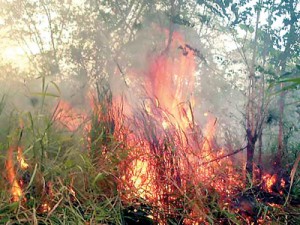News
Forest fires, deliberate in some cases, finish off native plants
The Nilgala herbal forest in the Monaragala District from where medicinal plants are obtained for Ayurvedic treatments was among several areas from where wildfires were reported this week.
Forest fires, mostly in parts of the Baddulla and Monaragala Districts destroyed plants and animals as well as endemic and rare plants.

Forest fires destroy endemic and rare plants. Pic by Sumanasiri Gunathilake
Adviser of the Uva Provincial Department of Ayurveda, Piyal Marasinghe, said highly valued medicinal plants could become extinct if such wildfires caused by humans continued.
“Although large medicinal trees such as Bulu, Nelli and Aralu survive these fires, rare herbal plants like Vanaraja, Kadulessa, Bin Kohomba suffer significant damage during July and August when forest fires are more common,” he said.
He said herbs such as Bin Kohomba which are effective in treating viral flu and threatened species including Duhudu have been destroyed in forest fires reported in the Nilgala forest.
According to a report by the Forest Department last year, fires had damaged more than 2,300 hectares (5,683 acres) of forest cover. This year, Monaragala and Badulla were the worst affected. Last year, 469.9 hectares (1,161 acres) and 229 hectares (565 acres) of forest cover was affected in Badulla and in Monaragala districts respectively.
This year, an estimated 161 ha (400 acres) have been destroyed in forest fires in the Monaragala District.
Districts such as Matale and Kandy which were severely affected by forest fires last year with about 257.8 ha (637 acres) and 240.3 Ha (593 acres) respectively, they have not yet been significantly affected this month. However, district officials predict more fires, especially during August.
A few other incidents were also reported at the beginning of this month in Anuradhapura District.
A H Ravindra Kumara, assistant director of the disaster management unit, Monaragala District, said the dry spell is the major reason for the rapid spread of the fires.
At the time we were speaking to him on Thursday evening, he said out of the four forest fires reported on Wednesday, two had been doused with the assistance of the area residents, forest conservation officials and the army while the other two in Kotabowa shrub jungle and Kumbukkana Kalawalaragama reserve had not been doused.
Please turn to Page 13
Mr Kumara said some fires are set deliberately, while there also are instances of negligence.
“Poachers set fire to forests to trap animals. One trick is to set fire from one side and wait at the other side to catch them, or sometimes they catch the animals that come to eat the tender grass that grow after a fire,” he said. He added that there were also instances when people set fire to illegally grab land that belongs to reserves and forests.
Sand miners are another group largely responsible for fires on slopes and hilly areas, Mr Kumara said. He said that when vegetation on slopes are set alight in the dry season by sand miners, the sand washes off to the rivers in the rainy season. “This allows the miners to extract more sand from river beds,” he explained.
Illegal cannabis growers also often set fire to grasslands. Then they grow cannabis plants which are concealed amid tall grasses such as mana.
According to him, forest fires are common in Obbegoda, Kumbukgoda, Buththala and Wellawaya.
E M L Udaya Kumara, assistant director of Badulla District Disaster Management Coordination Unit said about five forest fires are reported to him every day.
He said forest fires are common in Hali Ela, Ella, Bandarawela, Koranathota, Meegahakiul, and Lunuwela areas.
Hali Ela Divisional Secretary in Badulla said more than 32 ha of forests had been destroyed in the Hali Ela divisional secretariat alone this month while many small patana areas too, had been affected due to fires.
Mr Kumara said illegal loggers and game hunters are setting fires along with livestock owners who try to clear the land to regenerate grass for their herds. But there are also arsonists seeking cheap thrills.
“Usually those who intentionally set fires do so in the evenings or at the night especially on Saturdays and Sundays,’’ he said.
He said water catchment areas, commercial plantations, forest plantations and even business ventures, schools, water lines suffer damage.
Environmentalists claim that all fires are caused by Sri Lankans.Supun Lahiru Prakash, president of the Biodiversity Conservation and Research Circle, said forest fires destroy many endemic species. “We have found monkeys, loris and pangolin trapped in fires,” he said.
One adverse outcome is the spread of invasive species when native species are destroyed in fires.
Mr Prakash said the destruction alters the climate and the hydrological cycle.
He said the capacity of rivers is also reduced when silt builds up due soil erosion. Agricultural lands are damaged as well.
Meanwhile, Nanda Kumara, conservator of forests, protection and law enforcement of the Forest Department, said efforts are underway to reduce forest fires.
They include awareness programmes among the public and school children, forest restoration, deploying watchmen and creating fire belts. In some forests, a 22 foot wide portion has been removed to prevent fires from burning deep into the interior areas.

